Overview
The article underscores the crucial role of core strength for seniors, presenting seven essential ab workouts aimed at enhancing stability, balance, and overall mobility. Engaging in these workouts not only mitigates the risk of falls—a leading cause of injury among older adults—but also significantly boosts functional independence and quality of life. Research supports the assertion that regular core strengthening exercises yield substantial benefits, reinforcing the importance of incorporating these workouts into daily routines.
Introduction
As the golden years approach, maintaining physical health becomes increasingly vital for seniors, with core strength emerging as a key component of overall well-being. A robust core not only enhances stability and balance but also plays a crucial role in preventing falls—one of the leading causes of injury among older adults.
With staggering statistics revealing that millions of seniors experience fall-related incidents each year, the importance of core workouts cannot be overstated. This article delves into the myriad benefits of core training specifically designed for older adults, offering practical exercises, modifications for varying fitness levels, and strategies to seamlessly incorporate these workouts into daily routines.
By prioritizing core strength, seniors can significantly improve their quality of life, fostering independence and encouraging active participation in both social and physical activities.
The Importance of Core Strength for Seniors
Core strength is fundamental for seniors, playing a pivotal role in enhancing stability, balance, and mobility. With falls being the leading cause of fatal and non-fatal injuries among older adults—resulting in 14 million incidents annually—enhancing stability is a proactive measure to mitigate this risk. Research indicates that a strong central body significantly reduces the likelihood of falls, which is crucial given that over 44% of older adults in outpatient rehabilitation are at risk of falls.
Furthermore, the age-adjusted fall death rate rose by 41% from 2012 to 2021, reaching 78.0 per 100,000 older adults. In practical terms, a strong midsection assists older adults in carrying out daily activities such as rising from a chair, walking, and maintaining proper posture. Dr. Jennifer L. Vincenzo emphasizes that understanding fall risks is essential, stating that healthcare practitioners must help patients acknowledge their risk while highlighting the positive impact of fall prevention strategies.
By engaging in ab workouts for seniors, they can enhance their functional independence and overall quality of life, facilitating greater participation in social and physical activities. The economic burden of treating fall-related injuries is projected to exceed $101 billion by 2030, underscoring the importance of preventive measures like core strengthening.
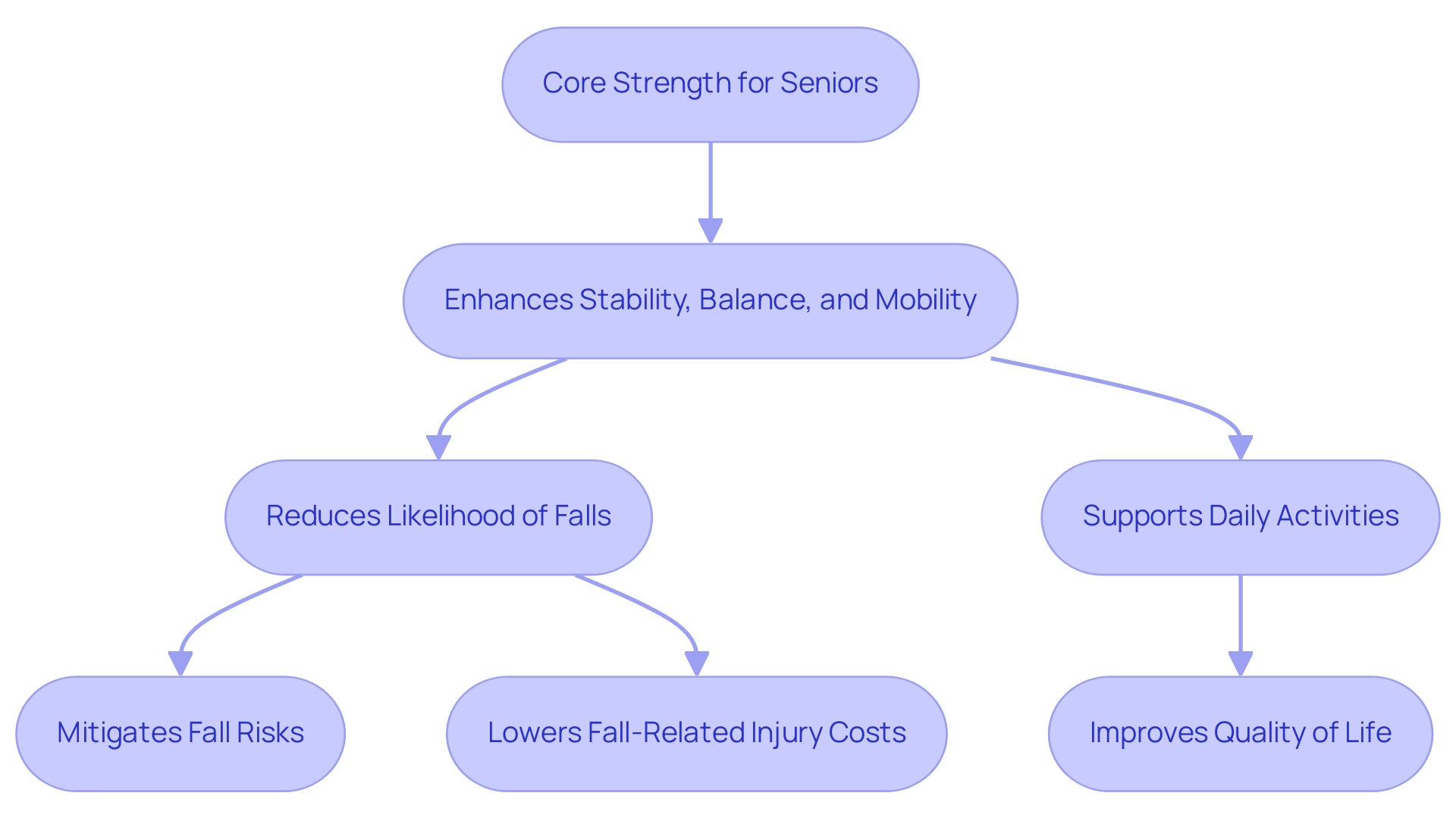
Benefits of Core Workouts for Older Adults
Ab workouts for seniors offer numerous advantages, significantly enhancing balance and stability, improving posture, and reducing the risk of back pain. Engaging in these activities under the guidance of skilled trainers is crucial for boosting mobility, allowing older adults to perform daily tasks with greater ease. Personalized coaching facilitates lasting lifestyle changes and empowers older adults to take charge of their health and well-being by equipping them with the knowledge and skills necessary for a healthier life.
Recent studies indicate that an 8-week program involving fundamental activities for 30 minutes daily, five times a week, can lead to substantial improvements in balance, particularly for older adults experiencing lower back discomfort. These routines are vital for maintaining autonomy. Furthermore, participating in basic workouts enhances physical capabilities and fosters confidence, promoting a more active lifestyle. This active engagement is essential for protecting both physical and mental health as individuals age.
Testimonials from participants highlight the effectiveness of personalized coaching in achieving these outcomes. As Le Ge noted, the datasets used in primary training studies are available for analysis, reflecting the growing interest in understanding the significant impact of these exercises on the well-being of older adults. However, as discussed in the study titled 'Limitations and Future Directions in Stability Research,' there are several limitations, including a lack of follow-ups and a brief intervention period, underscoring the necessity for further research to thoroughly investigate the benefits of training.
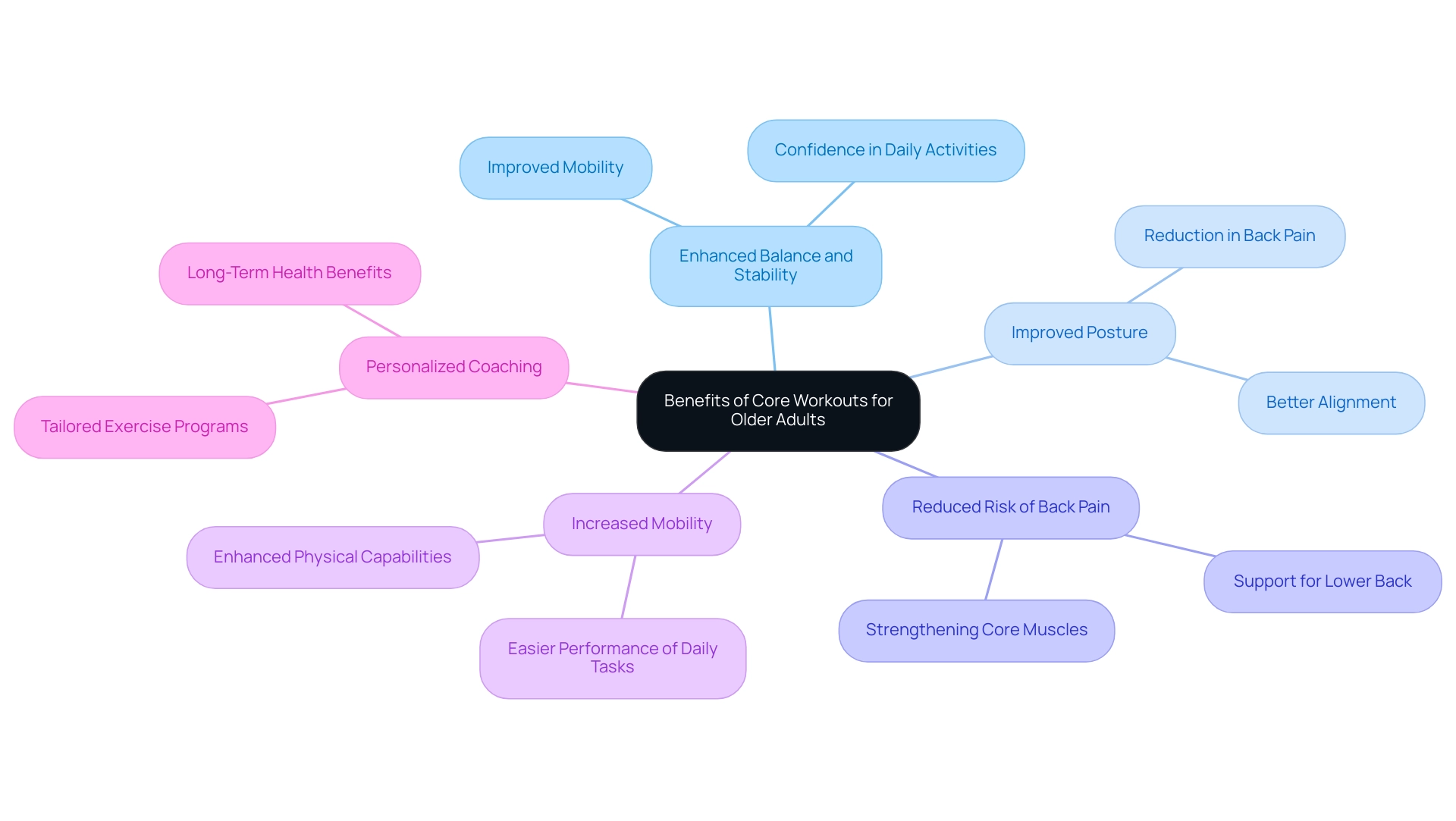
7 Essential Ab Workouts for Seniors
-
Seated Dead Bug: Begin by positioning yourself in a sturdy chair, lifting your legs off the ground. Alternate extending one leg while keeping the other bent, engaging your abdominal muscles throughout the movement. This exercise not only fortifies the trunk but also enhances coordination, making it one of the premier ab workouts for seniors. Research indicates that fundamental stability routines significantly contribute to overall strength, akin to the EMG activity observed in back squats, which averages around 75% of body weight.
-
Chair Plank: Position your forearms on the seat of a stable chair, ensuring your elbows align with your shoulders. Maintain a straight line from your head to your heels as you hold this plank position. This exercise enhances central stability and can be adjusted by changing the chair's height for comfort. According to the case study titled 'Impact of Exercise Type on Muscle Activation,' ab workouts for seniors, such as the chair plank, effectively activate abdominal muscles, particularly when performed with proper alignment.
-
Leg Lifts: While seated, elevate one leg at a time, ensuring your center remains engaged. This simple yet effective movement can help improve balance and is among the most beneficial ab workouts for seniors to strengthen the abdominal muscles. It serves as an excellent way to integrate fundamental training into a daily routine. The independent review of studies highlights the significance of ab workouts for seniors in enhancing central activation among older adults.
-
Bridge: Lie on your back with your knees bent and feet flat on the floor. Lift your hips toward the ceiling, forming a straight line from your knees to your shoulders. Hold this position briefly before lowering back down. This activity serves as one of the ab workouts for seniors, engaging the glutes and abdominal muscles to enhance overall stability.
-
Seated Side Bends: Sit up straight and lean to one side, extending your arm overhead to reach toward the ground. Return to the center and repeat on the other side. This movement engages the obliques and enhances lateral flexibility, which is crucial for daily activities.
-
Wall Sit: Stand with your back against a wall and slide down until your knees form a 90-degree angle. Hold this position, concentrating on sustaining stability throughout. This activity is excellent for developing endurance in the lower body while enhancing stability in the core.
-
Standing Side Leg Lifts: Stand tall and lift one leg out to the side, engaging your midsection for balance. This activity not only strengthens the hip and abdominal muscles but also improves overall stability and coordination, which are crucial for preventing falls. Marty Boehm, a physical therapist, emphasizes the significance of abdominal stability, stating, > Your abdominal muscles provide stability for the moving parts above and below them. < These ab workouts for seniors promote safety and functionality, making them ideal for older adults aiming to maintain an active lifestyle. By incorporating data from research and professional advice, these exercises are not only safe but also effective in improving strength among older adults.
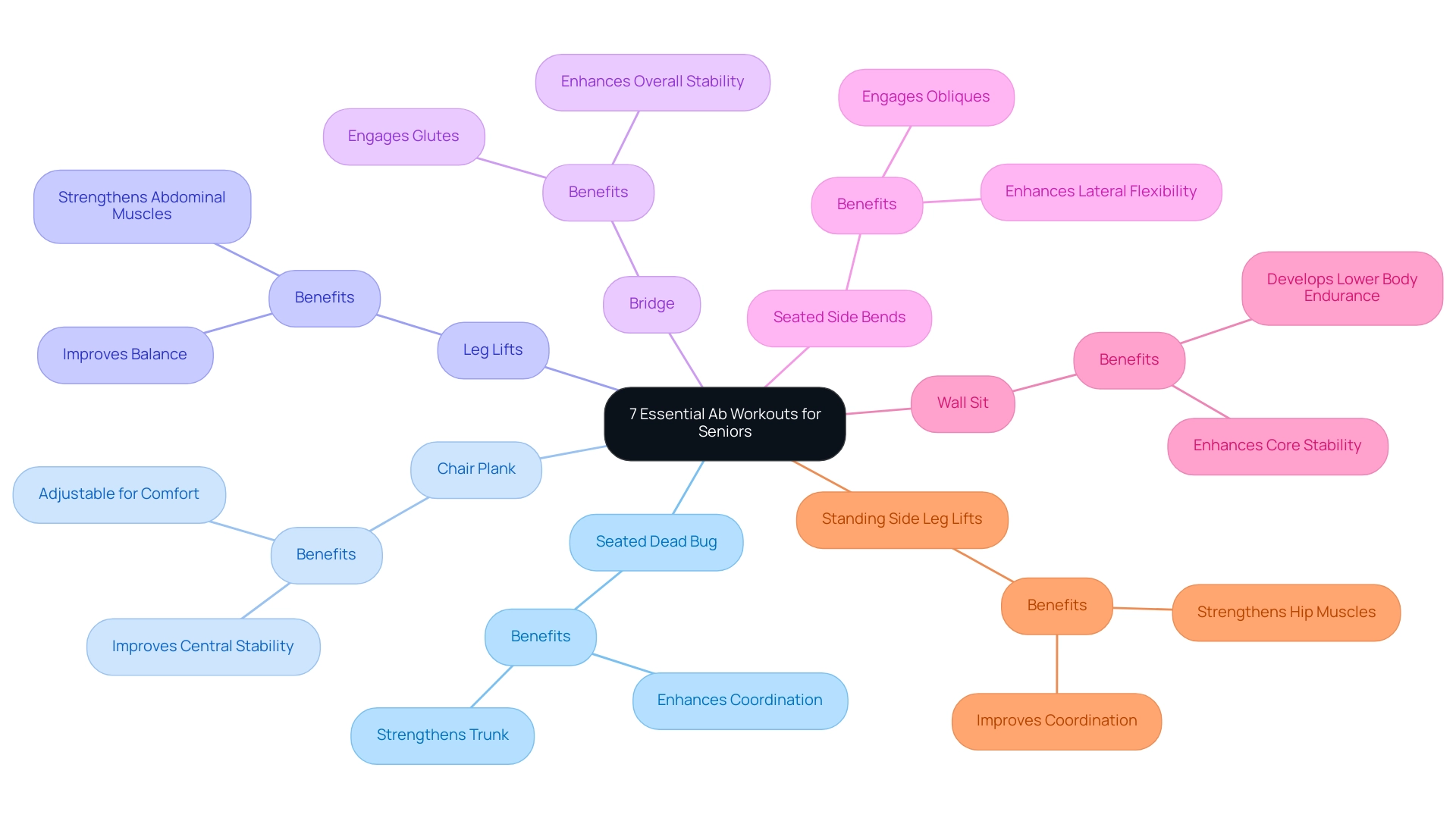
Modifications for Different Fitness Levels
For older adults experiencing restricted mobility, modifying fundamental workouts, including ab workouts for seniors, is crucial to guarantee safety and efficacy. Given that the average age of participants in relevant studies is at least 70 years old, these recommendations hold particular relevance for this demographic. Consider the following key modifications:
- Seated Variations: Incorporating activities like seated leg lifts or seated side bends minimizes strain while maintaining effectiveness. This approach allows seniors to safely engage their core through ab workouts without excessive risk.
- Use of Support: Utilizing a chair or a wall for balance during standing activities can significantly enhance stability, ensuring confidence while moving. This support is crucial, particularly for those who may feel unsteady.
- Gentle Progression: It's advisable to start with fewer repetitions and gradually increase as strength and confidence improve. This method aligns with individualized activity prescriptions shown to enhance health outcomes in older adults, emphasizing that physical activity should be tailored based on intended outcomes such as fitness improvement or treatment.
- Focus on Form: Emphasizing proper form over the number of repetitions is vital in preventing injuries. As pointed out by exercise specialists, this careful attention to technique is crucial for older adults, especially those with mobility challenges. Giovanni Melchiorri highlights that by using standardized sequences, it is possible to reduce therapist visits, achieving a better cost-effectiveness ratio.
By adopting these changes, older adults can safely participate in essential exercises, such as ab workouts for seniors, that enhance health and well-being, ultimately leading to improved overall fitness and quality of life.
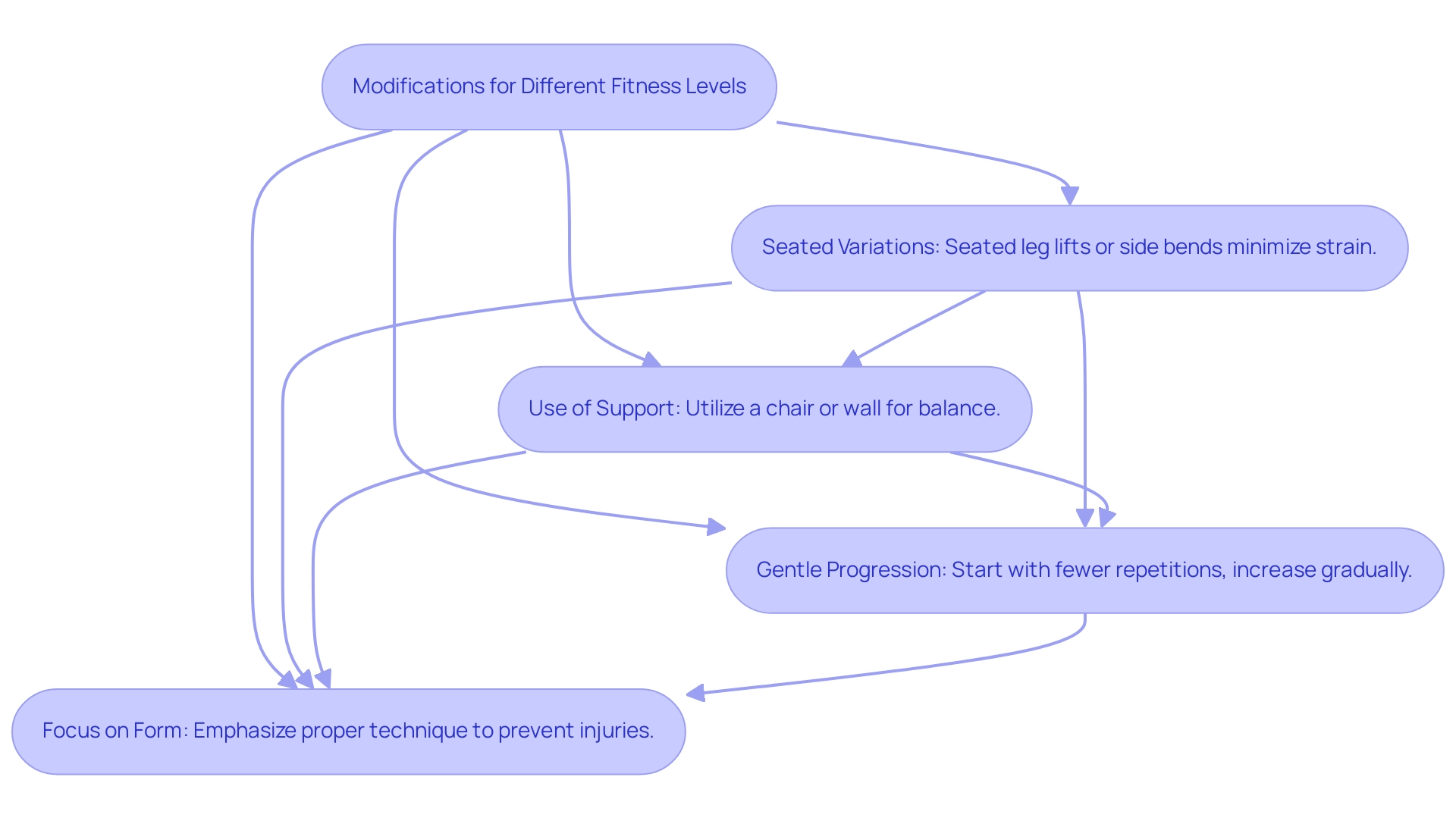
Incorporating Core Workouts into Your Routine
Incorporating essential exercises into a fitness regimen for seniors is crucial for improving overall health and stability. Consider the following effective strategies:
- Set a Schedule: Aim for at least two to three dedicated main exercise sessions per week to cultivate consistency and maximize benefits. This aligns with the recommendation to incorporate up to three days of ab workouts for seniors each week, reinforcing the importance of frequency in the fitness routine.
- Start Small: Initiate the routine with short sessions of 10-15 minutes, gradually increasing the duration as strength and endurance improve. This progressive method aids in avoiding exhaustion and promotes enthusiasm.
- Combine with Other Activities: Enhance the main workout experience by pairing it with supportive activities, such as walking or stretching. This holistic strategy promotes overall balance and fitness, making the routine more enjoyable.
- Track Progress: Maintaining a journal to document improvements in strength and endurance can significantly boost motivation. Consistently assessing progress not only promotes ongoing involvement but also emphasizes individual accomplishments.
A practical illustration of an effective fundamental activity for seniors is the Modified Plank. This exercise begins on hands and knees, lowering the upper body onto forearms while keeping the body straight. It focuses on tightening the abdominal muscles and enhances the strength and stability of the core through ab workouts for seniors. Seniors are encouraged to maintain the position and repeat it 10 times for optimal results.
As highlighted in recent studies, the methodology for ab workouts for seniors varies widely, underscoring the importance of a structured approach tailored to individual capabilities. Reed et al. concluded that performance in sports movements, like a golf swing or running, improves with trunk training, highlighting the benefits of a strong trunk.
Integrating these practices can result in significant enhancements in strength, ultimately aiding daily activities and overall well-being.
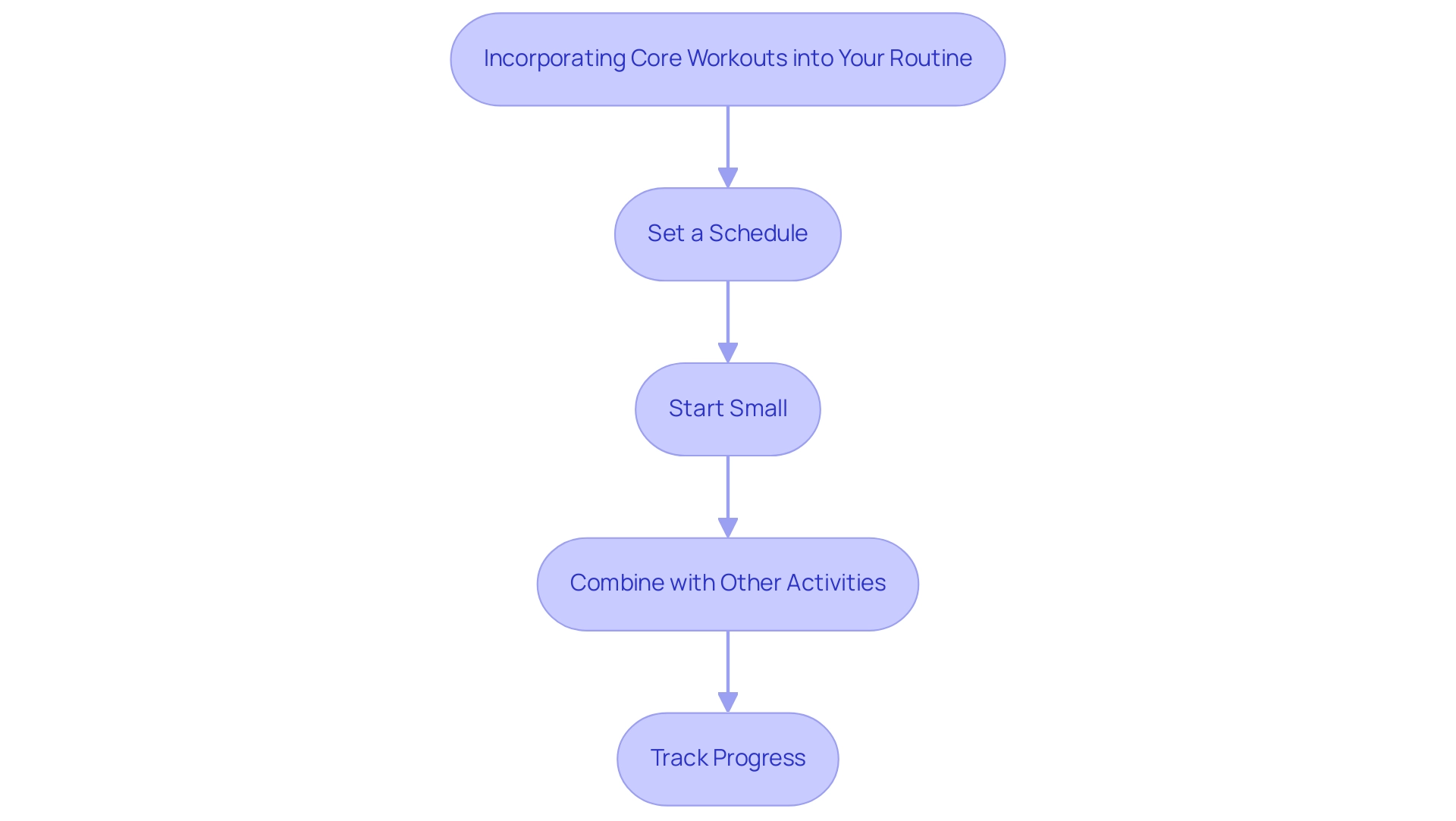
Common Mistakes and Tips for Safe Practice
When it comes to ab workouts for seniors, avoiding common mistakes is crucial for maintaining health and preventing injuries. Here are key pitfalls to steer clear of:
- Overexertion: It’s essential to start with manageable exercises and resist the urge to push too hard. Participating in shorter, more frequent exercise sessions can be more effective and safer. For instance, a suggested routine includes a five-minute strengthening session in the morning, a 20-minute walk at lunch, and a 10-minute practice in the evening. Research indicates that shorter, more frequent 'micro-workouts' can be just as effective, helping to prevent injury and setbacks.
- Poor Form: Maintaining proper posture is vital to prevent strain and injuries. Simple adjustments can make a significant difference in the effectiveness of the workout.
- Neglecting Warm-Up: Warming up is a non-negotiable step before any workout. As Dr. Allen Conrad advises,
I recommend warming up for at least five minutes, and ideally 10, before exercising. This preparation helps to reduce the risk of injury and enhances performance. - Ignoring Pain: It’s imperative to listen to your body. If an exercise causes discomfort or pain, it’s wise to stop and consult a professional. This practice not only aids in injury prevention but also encourages a sustainable fitness journey for older adults by incorporating ab workouts for seniors.
Furthermore, while cardio is beneficial for heart health, older individuals should also focus on strength and resistance training to improve bone density and overall mobility. By being aware of these frequent errors, older adults can participate in essential exercises that enhance strength and overall mobility safely.
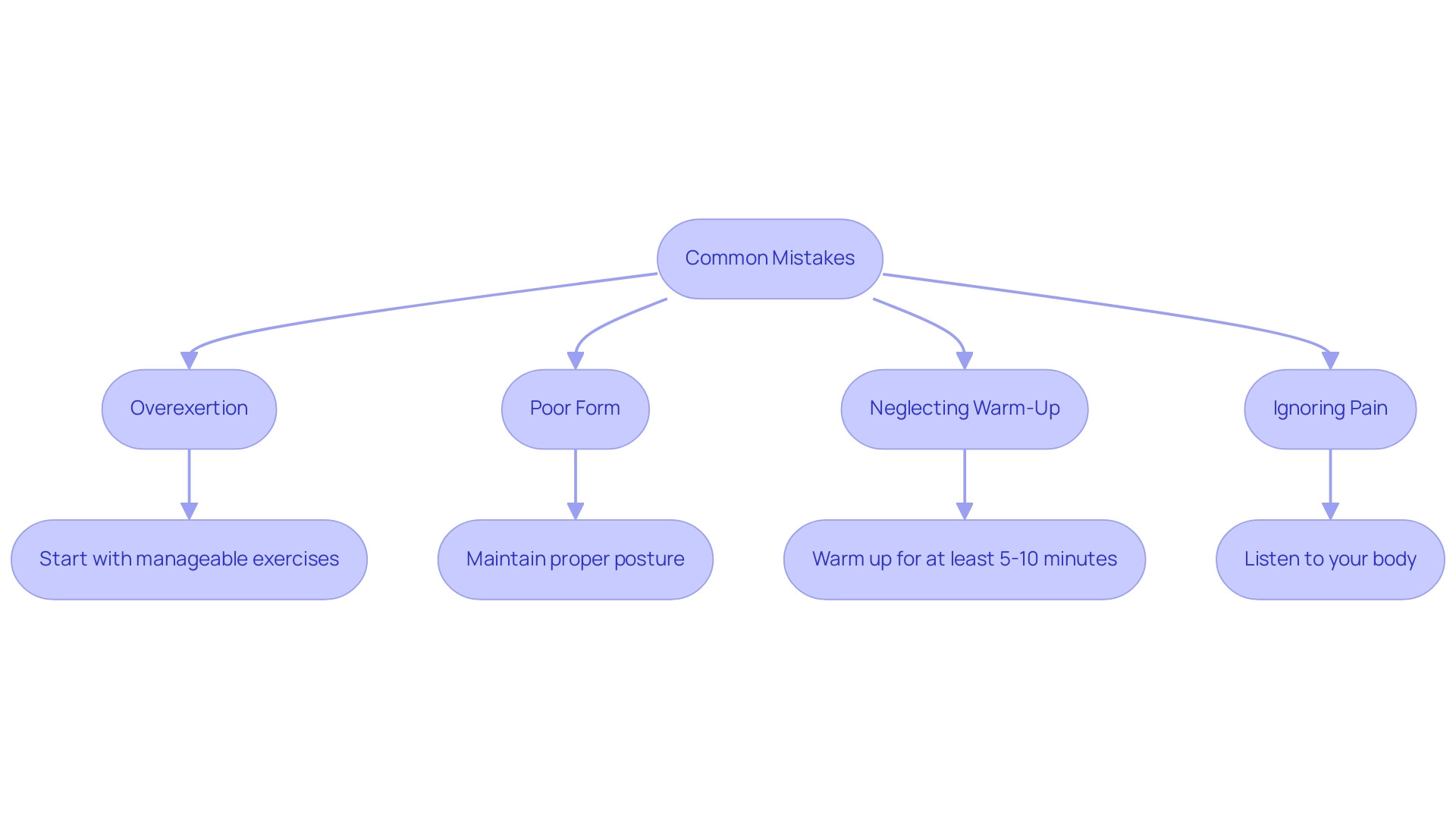
Staying Motivated: The Path to a Stronger Core
To sustain enthusiasm for essential exercises among older adults, consider the following strategies:
- Set Realistic Goals: Establish achievable fitness objectives that allow older individuals to track their progress. Breaking down larger goals into smaller, manageable milestones enhances motivation and creates a sense of accomplishment.
- Make it Social: Engaging friends or family in workouts not only enhances enjoyment but also fosters a sense of community. Debbie Lennox, a fitness coordinator at Canterbury Woods, shares, "We asked 4 of our residents who had been consistently training if they would serve as captains of teams, with 6 residents on each team. We explained they would each earn points for their team every time they used the HUR and cardio equipment." This method not only promotes involvement but also fosters friendship among older adults. Additionally, organizing fitness competitions can motivate older adults to engage more consistently as they work towards team goals, fostering a supportive environment.
- Celebrate Achievements: Acknowledge milestones, regardless of their size, to reinforce confidence and motivation. Recognizing progress encourages continued commitment to fitness goals.
- Focus on Benefits: Regularly remind older adults of the health benefits gained from ab workouts for seniors, including improved balance, enhanced strength, and reduced pain. Comprehending these positive results inspires them to prioritize their fitness routines.
- Encourage Regular Participation: Community centers can promote a multicomponent activity program that meets three times per week, reinforcing the significance of consistency in attaining fitness goals.
Through these strategies, community centers can create an environment conducive to physical activity, as highlighted in the case study on motivating senior residents to engage in physical activities. By providing tailored programs and emphasizing the positive impacts of exercise, such as improved health outcomes and increased social engagement through structured competitions, they can inspire older adults to lead more active and healthier lifestyles.
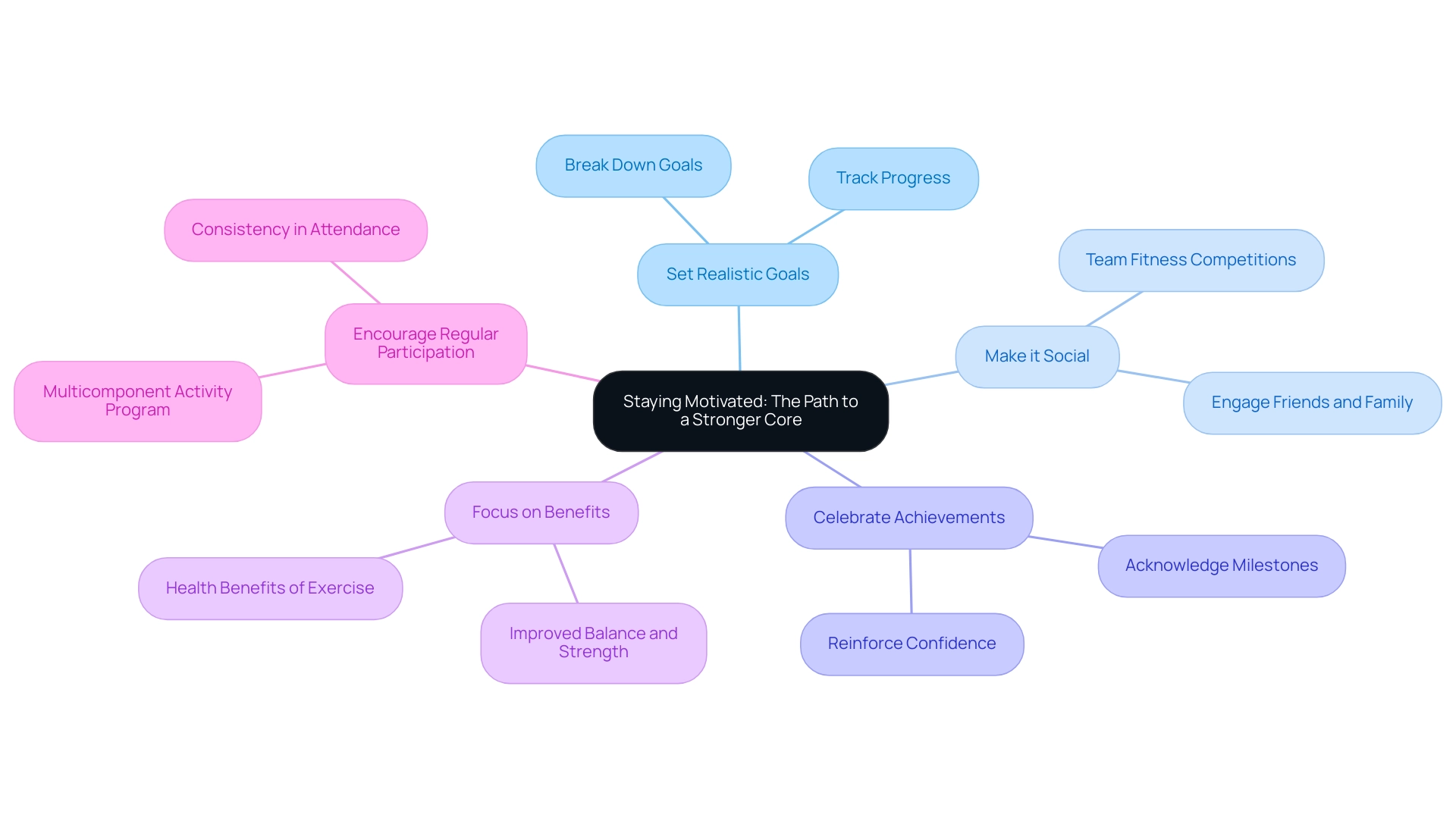
Conclusion
Core strength is undeniably vital for seniors, serving as a foundation for improved stability, balance, and overall mobility. With falls posing a significant risk and leading to millions of incidents each year, prioritizing core workouts becomes a proactive approach to enhance safety and independence. The benefits of core training extend beyond injury prevention; they encompass improved posture, reduced back pain, and greater confidence in daily activities.
By incorporating practical exercises tailored for varying fitness levels, seniors can engage in safe and effective workouts that bolster their core strength. Modifications ensure that individuals with limited mobility can still partake in these essential exercises, fostering a sense of accomplishment and well-being. Creating a structured routine, setting realistic goals, and tracking progress can significantly enhance motivation and commitment to fitness.
Ultimately, embracing core workouts is a powerful strategy for seniors to enhance their quality of life. By focusing on building a strong core, older adults can enjoy greater functional independence, participate more actively in social and physical activities, and reduce the risk of fall-related injuries. As the importance of core strength becomes increasingly recognized, the path to a healthier and more active lifestyle is clearer than ever—encouraging seniors to take charge of their health through consistent core training.




